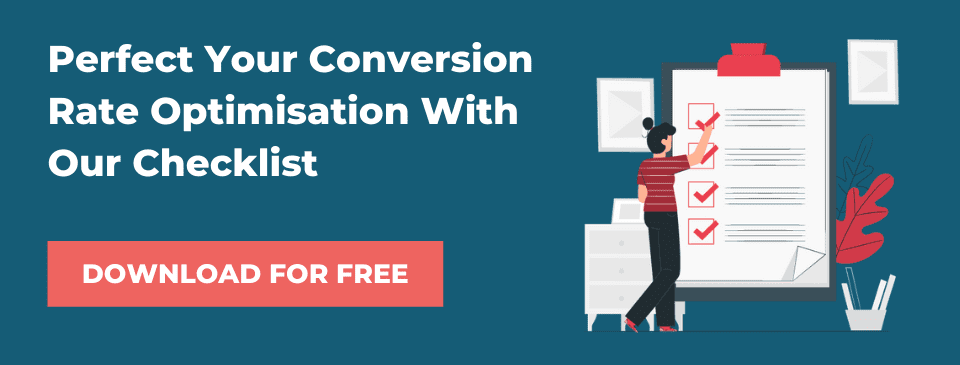7 most effective ways to increase the e-commerce conversion rate
For an eCommerce website, the main goal is to get products and content in front of the right people, at the right time, so they opt-in, engage or buy from your business. But if you want to achieve these goals, you have to make sure that you stand out from the busy crowd.
With this in mind, we’ve carefully gathered our seven most effective ways to increase your eCommerce conversion rate that will help you improve your conversions and sales. When thinking about how you can increase eCommerce conversion rate, firstly you must clearly define the typical conversions that can take place on your site:
- Online Sales (Checkout)
- Adding a product to the basket
- Adding a product to the wishlist
- Email Newsletter Signups
- Social Media Shares
- Any other e-commerce strategy KPIs that your company finds valuable
To make sure that you’ve got everything covered when creating your eCommerce strategy, make sure to head over to our step-by-step guide on how to create a complete eCommerce digital marketing strategy in 2021.
What is an average eCommerce conversion rate?
The average conversion rate for eCommerce websites is between 1% and 2%, even though you might be doing everything right. Essentially, a 2% conversion rate should be the primary goal for your online shop whilst trying to take small steps that can make incremental improvements to the overall shopping experience.
Once you’ve managed to reach a 2% conversion rate (and you’ve applied our following 7 tactics), you can move into more advanced conversion rate techniques.
1. High-quality visuals & detailed descriptions on product pages

When building, browsing or tweaking your eCommerce website, try to see it from your customer’s point of view whilst they’re shopping. The best thing you can do is to show detailed and high-quality images (or videos) so that customers know exactly what to expect.
Using high-quality content on all product pages will help users visualise the products a lot better and, therefore, increase your conversion rates. This will also make a big difference in your visitor retention rates and search engines rankings. Of course, designing an eCommerce website is essential in creating an excellent first impression, but the content will keep them coming back.
Here is our blog on a beginner’s guide to content marketing in case you’ve missed it.
2. Offer free shipping and limited-time coupons
Your prospective customers have come to your eCommerce website expecting to get a certain standard of the shopping experience (most of them are used to Amazon). This means that if your store doesn’t offer free shipping, buyers are going to look elsewhere, ditching your business in no time.
Accelerator
If you can’t offer free shipping, sharpen your psychological game by increasing your product prices to cover all shipping costs.
Additionally, providing coupon codes that people can use at checkout for a limited amount of time will make them even more interested in what you have to offer. This is because they can get a specific amount off or a percentage of the purchase price. Once the coupon codes expire, you will create a sense of urgency that will make the buyers go through with the purchase, without getting distracted so quickly.
3. Test and optimise the checkout process

The last thing users want is a long and complicated checkout experience when they wish to purchase. This is a commonly found reason why so many eCommerce businesses lose customers right as they’re ready to buy.
This is a crucial step in the sales funnel, where a lot of your A/B tests and strategies to personalise your website should take place, based solely on your customers.
Essentially, the check out process optimisation consists of eliminating unnecessary distractions to focus on finding and buying what they are searching for. It’s critical that all the necessary information is available and that the customer understands all the checkout process steps.
So, what you can do to make the checkout process simple and easy is:
- Set expectation and avoid confusion by using simple graphics
- Show the checkout progress to present the steps customers need to take to complete the checkout, and where are they standing at every step along the way
- Don’t ask for registration, as it can be immense friction for most eCommerce websites; this means that the best way to go about it is to offer a guest checkout procedure so people can enjoy a smoother buying experience
- Capture user’s email in the early process to be able to follow up with a good email campaign aimed at saving the sale, whilst building stronger relationships with your customers
- Keep buyers on the same domain, as directing them away from one site to another can cause disorientation and instil distrust
- Highlight the benefits of making the purchase, like free shipping, easy returns, coupon codes, and your concerns for their security whilst buying from you
- Provide real-time support with live chats
- Make your CTA’s clear, like “Add to Cart” as evident as possible on every single product detail page
- Use autocomplete and data validation to speed up the checkout process
- Follow up with an email to finalise the transaction
- Keep the shopping cart open as this will increase the chances of people adding more items to their cart
Accelerator
Additionally, you can track your eCommerce digital marketing performance by consistently checking your website analytics and using a tool such as HotJar to understand your customers better.
4. Use a cart abandonment software
Research has shown that shopping cart abandonment rates for eCommerce websites are around 67%, which is a very high percentage. In this case, you can use an abandoned cart software, which can significantly increase your eCommerce conversion rates.
This kind of software works with users that added products to their shopping cart, entered their emails and details, and then left the online store. Some software allows you to create follow-up emails that send people an email with their cart contents, whilst giving them coupon codes to get discounts as incentives to complete their orders. Pretty smart, right?
Decreasing abandonment rates must be a vital priority for eCommerce websites, considering people have already expressed interest in the products. Research states that some eCommerce stores benefit from up to a 30% increase in their website conversion rate using cart abandonment software.

5. Provide product reviews and testimonials
Let’s put it this way – why do so many people buy from Amazon? Because of the reviews and testimonials!
Try to remember when was the last time you thought to make a purchase, did you search for reviews before buying? We bet you did! A great tactic is to offer potential and current customers coupon codes (or other types of incentives) the next time they purchase from you as a reward for providing online reviews and testimonials for your business. Note that testimonials are way more potent than a simple list of features, as they prove that your products work.
Also, ask people to express their complaints to you to address their issues, which will help you receive even more positive reviews and feedback. Another way to capture your customer’s feedback is by using third party sites such as Trustpilot and Reviews.io, to add extra credibility to your eCommerce website.
6. Have a good product return policy
Did you know that over 50% of your customers will read your return policy before buying?
Try to avoid over-promising, but make it as easy as possible for people to return their products, based on good reasoning. Even though this may not sound like CRO, it’s a straightforward example of how to increase your website conversion rate in no time. This is because a concise and transparent return policy can give people a strong sense of security, as what they’re promised to be buying is guaranteed to be just that.
If your eCommerce store doesn’t provide this guarantee, don’t be surprised if your consumers will often be suspicious and ultimately avoid purchasing from you.
7. Optimise your eCommerce website for mobile devices
Usually, mobile devices account for more than one-third of retail sales. So, if your eCommerce store doesn’t have an exquisite mobile experience, you are on the verge of missing out on a large number of sales!
The first sales-killer for most eCommerce websites is a slow loading speed, which immediately leads to a poor user experience. Keep in mind that internet connection can sometimes be slower on mobile devices, making users much more impatient. To enhance your user experience and mitigate people’s frustration, you must ensure that your eCommerce site loads quickly.
To find out your eCommerce website loading speed, you can use the Google Mobile-Friendly Tool.
If you’re looking for some quick tips on how you can optimise your eCommerce website for mobile devices, we have some for you right here:
- Eliminate unnecessary words from your product pages, whilst keeping in mind that mobile searchers are particular in their queries
- Don’t use popups and sidebars as they are irrelevant
- Ensure you have a responsive and eye-catching website design
- Use user-friendly navigation and ensure that essential pages on your website are easy to find, fully accessible, and clickable, to encourage users to stay on your site for more extended periods
If you are looking for better results from your eCommerce website, but you don’t know where to start, we’ve got you covered. You can book a free eCommerce digital marketing consultation with us and our expert team of digital marketers can evaluate your eCommerce website to find the key areas that need improvements to increase your conversion rate.
Even better, why not give us a shout and book a free conversion rate optimisation consultation with us to see how we can reach your eCommerce goals together?
In the meantime, for more tips and tricks, make sure to check out our blogs on how to run A/B testing for conversion rate optimisation, 5 best practices for eCommerce landing pages, and how to turn traffic into conversions.





